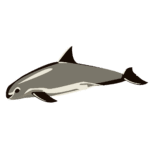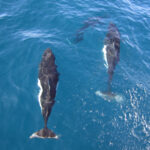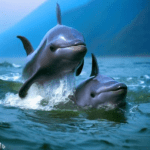Meet the Dall Porpoise! Also known as Phocoenoides dalli, these fascinating marine mammals live in Alaska’s waters. They have black and white coloring that helps them blend in with their surroundings. Plus, their streamlined shape and small size make them well-adapted for life in the Arctic.
They’re speedy swimmers, too! Dall Porpoises can reach speeds of up to 55 kilometers per hour. Plus, they often jump out of the water and ride boats’ bow waves. They mainly feed on fish and squid, using echolocation to find their prey.
These porpoises are also awesome divers. They can dive as deep as 200 meters to hunt for food or to avoid predators. But how do they survive in the cold waters? Thanks to a thick layer of blubber, they stay warm!
Plus, researchers have seen them engage in cooperative hunting. That means they work together to herd fish into tight formations, making it simpler to catch their dinner. Ready to learn more about these acrobatic swimmers? Dive into the world of Dall Porpoises!
Key Takeaways
- The Dall Porpoise is a small marine mammal found in the waters of Alaska.
- They are known for their distinctive black and white coloring, which helps them blend in with their surroundings.
- Dall Porpoises are highly skilled swimmers and can reach speeds of up to 55 km/h.
- They primarily feed on fish and squid, using echolocation to locate their prey.
- The population of Dall Porpoises in Alaska is currently stable, but they face threats from pollution, habitat loss, and entanglement in fishing gear.
- Conservation efforts are being made to protect the Dall Porpoise population, including the establishment of marine protected areas and regulations on fishing practices.
- Researchers are studying the behavior and ecology of Dall Porpoises to better understand their needs and develop effective conservation strategies.
- The presence of Dall Porpoises in Alaska’s waters is not only important for the ecosystem but also for the tourism industry, as they are a popular attraction for wildlife enthusiasts.
- It is crucial for individuals and organizations to support conservation initiatives and raise awareness about the importance of protecting the Dall Porpoise and its habitat.
Overview of the Dall Porpoise species
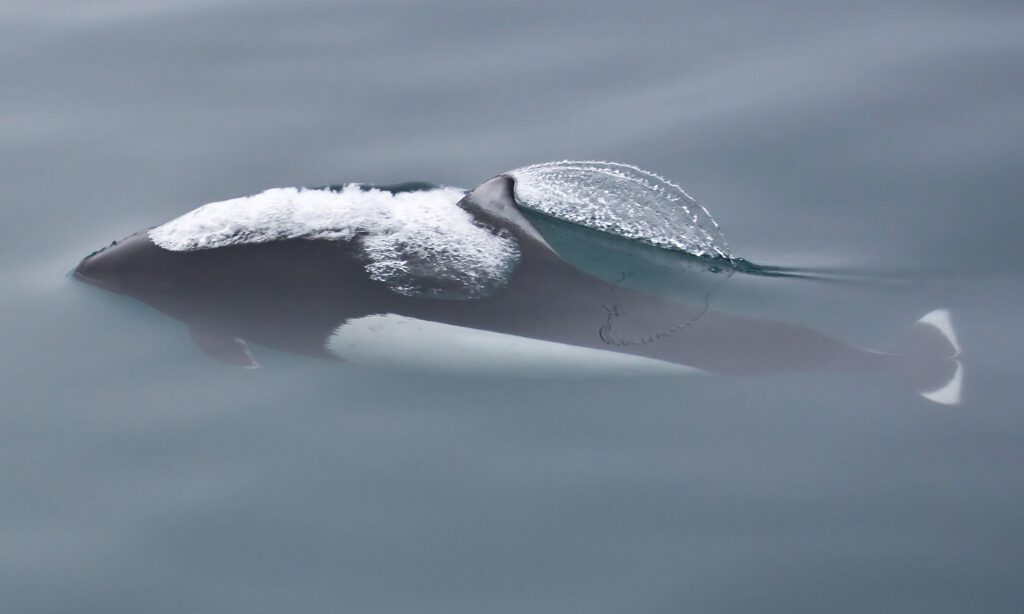
licensed under (CC BY-SA 2.0)
These porpoises are a majestic marine mammal found in the waters of Alaska. They have a sleek and streamlined body, perfect for fast swimming and maneuvering. Plus, they have a striking coloration: dark grey back and white patches on their sides, plus a tall triangular dorsal fin!
Not only that, but they can reach speeds of up to 55 kilometers per hour – one of the fastest marine mammals in the world! They’re also highly social, often seen in small groups or pods. Playing and leaping out of the water, they even ride alongside ships.
Unlike other cetaceans, Dall Porpoises don’t have a prolonged period of nursing for their young. They have short lactation periods, lasting only a few months, which allows them to reproduce quickly and efficiently.
The species is named after W.H. Dall, an American naturalist who described them in the late 19th century. With their captivating appearance and remarkable abilities, Dall Porpoises remain fascinating to researchers and nature enthusiasts alike.
Habitat and Distribution of Dall Porpoise in Alaska
Say hello to the Dall Porpoise, Alaska’s own unique species! Found all over the coastal and offshore waters, they especially love the icy cold waters of the Bering Sea and Gulf of Alaska. These porpoises are easily recognizable with their black and white slender bodies, reaching up to 7 feet long and 300 pounds! And they can swim up to 55 kilometers per hour – wow!
Unlike other porpoise species, these guys prefer deeper waters, but will come near shore to hunt for walleye pollock and Pacific herring. Amazingly, they have an echolocation ability to detect their prey in the vast ocean!
The Dall Porpoises’ intelligence and empathy were on full display when a group of them surrounded a stranded swimmer off the coast of Alaska until help arrived. Truly incredible!
Studying these mysterious creatures reveals more about their habitat, distribution patterns, and remarkable adaptability and unique behaviors. Who knows what else we’ll learn about them!
Physical Characteristics and Behavior of Dall Porpoise
Dall Porpoise are a captivating kind of marine creature. With their black and white coloring, and sleek body, they are hard to miss. And their behavior is even more intriguing. They’re known for leaping out of water and riding boat bow waves with ease, and they often travel in social pods.
They have specialized teeth which helps them hunt swiftly-moving prey like fish and squid. It’s an adaptation that showcases their hunting skills. To protect them, it’s important to follow certain guidelines when observing them. Like keeping noise levels low, avoiding sudden movements, and not attempting to touch or feed them.
By following these, we can help conserve Dall Porpoise for future generations. It’s a crucial swim to ensure their preservation.
Threats and Conservation Efforts for Dall Porpoise in Alaska
Alaska’s Dall Porpoise are in danger! Fishing, pollution and climate change have all had an impact on their population. To save them, conservation measures must be taken quickly.
Fishing practices like drift netting and gillnetting can result in bycatch – where porpoises get caught in nets meant for other fish. This has a huge effect on their numbers. To save them, we must promote sustainable fishing practices that reduce bycatch incidents.
Pollution from industries and marine debris can accumulate in porpoise bodies through the food chain. This can lead to health issues and impairments. Regulations on waste disposal must be implemented and eco-friendly practices promoted to reduce these risks.
The melting of Arctic sea ice has had a major impact on the Dall Porpoise’s habitat and prey availability. Changes in water temperature and acidity could further threaten their ecosystem. We must be proactive in fighting climate change to protect these animals.
It’s our duty to save the Dall Porpoise! By supporting sustainable fishing, advocating against pollution and participating in climate change initiatives, we can ensure their survival for future generations to enjoy. Let’s take action now to make a difference!
The Role of Dall Porpoise in the Ecosystem
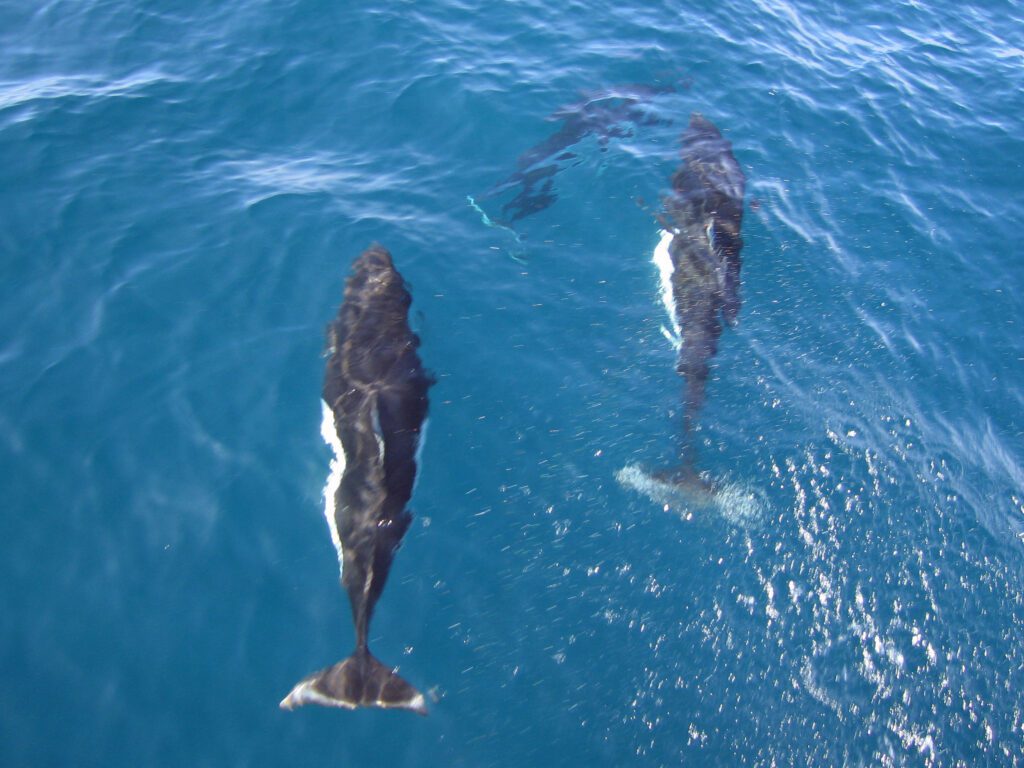
Dall Porpoise – a vital part of Alaskan life – has various roles that keep the ecosystem balanced and stable. They are middle-tier predators, mainly eating fish like herring and salmon. This helps prevent overgrowth of certain populations. Plus, they provide food for bigger predators like killer whales.
Their incredible swimming abilities help them hunt and escape threats, keeping them safe and maintaining the ecosystem. They also travel in pods of around 15 individuals, communicating with clicks and whistles. This creates strong social bonds, aiding successful hunts and fostering community.
Unfortunately, these intelligent creatures have historically been hunted for their meat and blubber. This caused a decline in their numbers during the early 20th century. Luckily, conservation efforts have helped revive their numbers.
Dall Porpoise Watching and Tourism in Alaska
Dall Porpoise watching in Alaska is an experience like no other! Tourists can embark on thrilling boat trips to catch glimpses of these agile creatures. The breath-taking coastal scenery provides a stunning backdrop for the adventure.
Guided tours offer educational opportunities and emphasize the importance of protecting these animals and their fragile marine ecosystem. When planning to view Dall Porpoises, it is important to:
- Choose reputable tour operators who prioritize responsible wildlife viewing practices.
- Dress appropriately for the weather conditions and bring necessary equipment.
- Follow instructions provided by tour guides to maximize safety.
- Respect wildlife by maintaining a respectful distance.
By following these suggestions, visitors will have a memorable experience and contribute to the conservation of this incredible species.
Interaction between Dall Porpoise and Humans
- Dall Porpoises – these charismatic marine mammals in Alaska – have a distinct relationship with humans. So let’s dive in!
- Tourism: Dall Porpoises often attract tourists in places like Glacier Bay National Park, who want to watch their lively behavior.
- Fishing: Porpoises can follow fishing vessels and snatch an easy meal from the nets.
- Accidental Capture: Sadly, they can get entangled in fishing gear and become bycatch, putting their population at risk.
Plus – there have been cases of Dall Porpoises playing with floating objects, and even approaching boats out of curiosity! Such behavior gives us insight into how they interact with people.
A kayaking group in Alaska were mesmerized by a pod of Dall Porpoises swimming near them – their elegance and agility created a real connection.
To protect these adorable creatures, research and protection is needed – which is easier than trying to convince cats that lasers aren’t real!
Future Research and Protection of Dall Porpoise
A table below displays the advancements in Dall Porpoise research and protection:

Experts agree that teaming up researchers, policymakers and local folk is key for successful conservation plans to decrease bycatch. Also, having knowledge of the social, economic and cultural importance of Dall Porpoise is essential for sustainable management.
Throughout the late 20th century, population decline worries prompted tighter rules on fisheries to reduce bycatch. This denotes significant progress ensuring the survival of these remarkable marine creatures.
Despite Dall Porpoise’s survival rate not being great, they have a delightful sense of humor – they’re always laughing!
Frequently Asked Questions
Q: Where can the Dall porpoise be found in Alaska?
A: Dall porpoises are commonly found in the coastal waters of Alaska.
Q: What do Dall porpoises eat?
A: Dall porpoises primarily feed on squid and small fish species like herring and capelin.
Q: How fast can Dall porpoises swim?
A: Dall porpoises are known to be incredibly fast swimmers, reaching speeds of up to 55 kilometers per hour (34 miles per hour).
Q: Are Dall porpoises endangered?
A: No, Dall porpoises are not considered endangered. They have a stable population and are not currently facing any major threats.
Q: What is the average lifespan of a Dall porpoise?
A: Dall porpoises typically live for around 15 to 20 years in the wild.
Q: Are Dall porpoises social animals?
A: Yes, Dall porpoises are highly social animals and often travel in small groups called pods.
Conclusion
Exploring the Dall Porpoise in Alaska revealed its beauty and adaptability. Sleek bodies and playful nature make them beloved by all. Their skillful swimming is aided by streamlined bodies and unique adaptations. One detail is their black-and-white pattern, which provides camouflage and helps them hunt.
The porpoises were named after William Healey Dall, a naturalist who studied Alaska’s fauna. His passion for exploration revealed much about this species.
We have seen that these creatures are truly a marvel of nature. With agility, captivating appearance, and historical significance, they are an essential part of Alaska’s marine ecosystem. Let us cherish and protect them for future generations.
References

